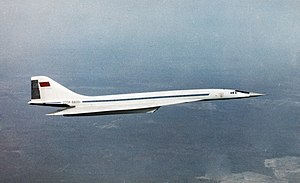
Back Toepolef Tu-144 Afrikaans Tupolev Tu-144 AN توبوليف تي يو 144 Arabic Tupolev Tu-144 Azerbaijani Ту-144 Bulgarian Tupoljev Tu-144 BS Túpolev Tu-144 Catalan Tupolev Tu-144 Czech Ту-144 CV Tupolev Tu-144 Danish
| Tu-144 | |
|---|---|

| |
| Tu-144 prototype in flight on 1 February 1969 | |
| Role | Supersonic airliner |
| National origin | Soviet Union |
| Manufacturer | Voronezh Aircraft Production Association |
| Design group | Tupolev OKB |
| First flight | 31 December 1968[1]: 76 |
| Introduction | 26 December 1975[1]: 76 |
| Status | Retired from passenger service (1978) Retired from commercial service (1983) Retired (1999) |
| Primary users | Aeroflot Ministry of Aviation Industry NASA |
| Produced | 1967–1983 |
| Number built | 16 |
The Tupolev Tu-144 (Russian: Tyполев Ту-144; NATO reporting name: Charger) is a Soviet supersonic passenger airliner designed by Tupolev in operation from 1968 to 1999.[2]
The Tu-144 was the world's first commercial supersonic transport aircraft with its prototype's maiden flight from Zhukovsky Airport on 31 December 1968, two months before the British-French Concorde.[1]: 76 [3] The Tu-144 was a product of the Tupolev Design Bureau, an OKB headed by aeronautics pioneer Aleksey Tupolev, and 16 aircraft were manufactured by the Voronezh Aircraft Production Association in Voronezh.[1][page needed] The Tu-144 conducted 102 commercial flights, of which only 55 carried passengers, at an average service altitude of 16,000 metres (52,000 ft) and cruised at a speed of around 2,200 kilometres per hour (1,400 mph) (Mach 2).[4][5] The Tu-144 first went supersonic on 5 June 1969, four months before Concorde, and on 26 May 1970 became the world's first commercial transport to exceed Mach 2.[5]
Reliability and developmental issues, together with repercussions of the 1973 Paris Air Show Tu-144 crash and rising fuel prices, restricted the viability of the Tu-144 for regular use. The Tu-144 was introduced into commercial service with Aeroflot between Moscow and Alma-Ata on 26 December 1975 and starting 1 November 1977 passenger flights began; it was withdrawn less than seven months later after a new Tu-144 variant crash-landed during a test flight on 23 May 1978. The Tu-144 remained in commercial service as a cargo aircraft until the cancellation of the Tu-144 program in 1983. The Tu-144 was later used by the Soviet space program to train pilots of the Buran spacecraft, and by NASA for supersonic research until 1999. The Tu-144 made its final flight on 26 June 1999 and surviving aircraft were put on display across the world or into storage.
- ^ a b c d Gordon, Yefim; Rigmant, Vladimir (2005). Tupolev Tu-144. Hinckley, Leicestershire, UK: Midland. ISBN 978-1-85780-216-0.
- ^ Prisco, Jacopo (28 September 2017). "How the Soviet Concorde crashed and burned". CNN Style. Archived from the original on 10 November 2021. Retrieved 19 January 2019.
- ^ David Kaminski-Morrow (31 December 2018). "Retrospective: Tu-144 beats Concorde to first flight". FlightGlobal. Reed Business Information Limited. Archived from the original on 14 February 2019. Retrieved 13 February 2019.
- ^ Dowling, Stephen (18 October 2017). "The Soviet Union's flawed rival to Concorde". BBC. Archived from the original on 10 November 2021. Retrieved 7 August 2019.
- ^ a b "Tu-144 – Туполев" [Tu-144 – Tupolev]. Archived from the original on 17 August 2018. Retrieved 13 September 2014.